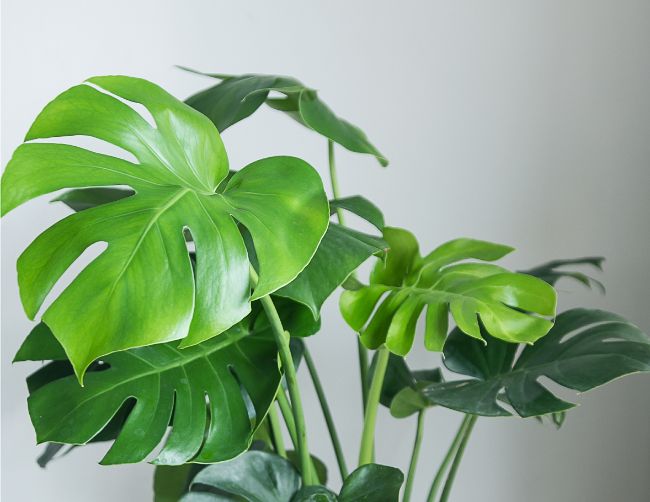With its big and bold evergreen tropical foliage, Monstera deliciosa is sure to bring an eye-catching and exotic appeal wherever it finds its indoor home. When its basic requirements for care are met, this member of the Araceae should grace your indoor space with hardy growth for years to come. Below we’ve given a short summary of how to care for monstera deliciosa for problem-free growth.
How To Care For Monstera Deliciosa: Keep your Monstera deliciosa healthy by growing it in rich, well-draining soil, fertilizing monthly and watering when the top several inches of soil become dry. Maintain moderate humidity and situate in an indoor location receiving bright indirect or filtered light and with temperatures of 70-75°F.
Whether you are considering adding a Monstera deliciosa to your indoor plant collection, or already have one gracing your home, continue reading because we have taken all the mystery out of properly growing this tropical beauty.
Summary Of Monstera Deliciosa Care
- Scientific Name: Monstera deliciosa
- Common Name: Swiss Cheese Plant, Fruit Salad Plant, Split-Leaf Philodendron
- Origin: Rainforest regions from southern Mexico to Panama in Central America.
- Light Requirements: Bright, indirect light. Avoid more than 1-2 hours direct sunlight per day.
- Watering: Water thoroughly once the top 2 inches of soil is dry. Consider using filtered water or rainwater.
- Soil: Nutrient rich, well-draining potting mix. Equal parts potting soil, peat and perlite works well.
- Temperature: 70-75°F (21-24°C) is best. Won’t tolerate temperatures below 50°F (10°C).
- Fertilizer: Balanced, water-soluble fertilizer applied monthly through the growing season. I use this one.
- Humidity: Medium to high humidity, >40%.
- Flowering: Very unlikely indoors. Large spadix with white/yellow spathes.
- Pruning: Only necessary to control size and remove dead foliage.
- Propagation: Stem cuttings are easy to propagate.
- Re-Potting: Every 1-2 years. Increase pot size if you wish to maximize growth.
- Popular Varieties: Monstera deliciosa, Monstera deliciosa ‘borsigiana’, Monstera deliciosa ‘Thai Constellation’, Monstera deliciosa ‘Albo-Variegata’
- Diseases and Pests: Generally hardy, but prone to root rot, spider mites and mealybugs.
- Toxicity: Toxic if ingested and sap can also cause skin irritation.
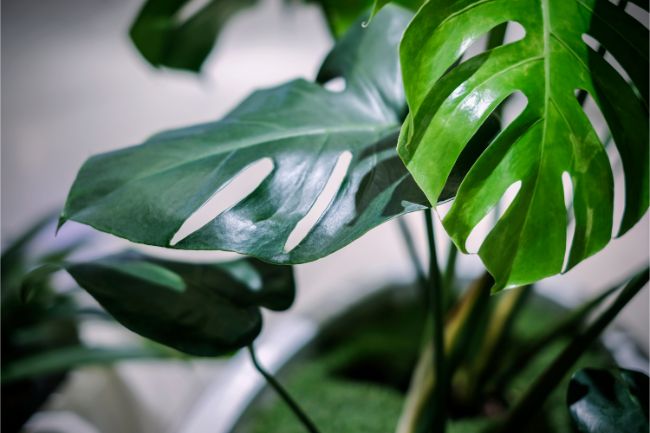
Characteristics Of Monstera Deliciosa
Monstera deliciosa is considered a tropical vine native to the rainforest regions from southern Mexico to Panama in Central America. Although it thrives outdoors in frost-free regions performing as either a vine or large ground cover, it has been a popular foliage houseplant since the 18th century, when it was introduced into England.
Monstera deliciosa goes by a wealth of common names due to the splits in the leaves. Names like Swiss cheese plant, split-leaf philodendron (although not a philodendron) and fruit salad plant, due to the edible fruit, are all common names for this plant.
The heart-shaped, glossy green leaves develop horizontal splits as they mature, can be more than 12 inches in diameter when grown indoors. Outdoors in their preferred climate, Monstera deliciosa leaves can reach over 3 feet wide.
The large leaves form along thick green stems lined with long aerial roots that resemble tannish cords. These aerial roots assist the plant in climbing up and upon a structure, if one is used. Unless grown in a location like a sunroom or greenhouse that can mimic Monstera deliciosa’s preferred outdoor conditions, flowering and fruiting is rare on indoor plants.
When flowering occurs, the blooms are arum-like with the 10-inch spadix surrounded by a thick white spathe. The spent flowers develop into an edible fruit that tastes like a cross between a banana and pineapple and can take a year to ripen fully to the edible stage. Unripe fruit is considered toxic.
Although Monstera deliciosa is suitable for smaller indoor locations when immature, once they put on several years of proper growth, they’ll need a larger area to make room for the large foliage and its tall nature.
These turn into big plants even as houseplants and it’s not unusual for it to grow 8 feet tall, when grown on a moss lined plant pole. Outdoors, in perfect growing conditions, they can grow up to 30 feet tall. Whether small or fully-grown, the indoor addition of a Monstera deliciosa is sure to bring a taste of the tropics wherever placed.
Soil Conditions For Monstera Deliciosa
In its native habitat, Monstera deliciosa grows in the rich soil of the rainforest made up of decaying products like leaf debris. Therefore, it’s best to plant and grow yours in a rich soil mixture that drains properly. You don’t want to use a heavy soil with a tendency to retain too much water or your Monstera deliciosa can develop problems with root rot.
Planting in a well-draining peat-based potting mix is a good choice. I use an equal mix of potting soil, peat and perlite for my Monstera and it seems to work very well.
Whatever choice in soil you decide on, just make sure it is rich in organic materials and has good drainage. A good way to check the drainage of your proposed soil mix is to water it and if the water remains on top of the soil, it’s too heavy and requires a bit a lightening up by the addition of something like peat or perlite.
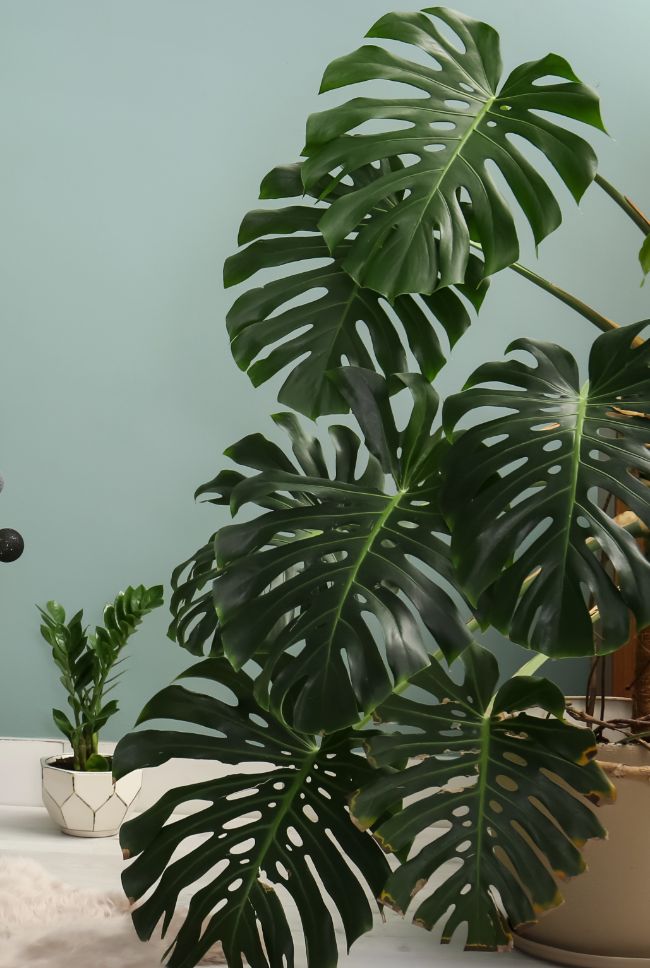
Light Conditions For Monstera Deliciosa
Monstera deliciosa tolerates growing in a wide range of light conditions, but will do best in bright, indirect light. Monstera will tolerate dimmer indoor light conditions but the plant will be smaller and grow less strongly.
In low light conditions you will have no chance of the plant flowering or producing fruit. In addition, the leaves on your Monstera deliciosa won’t develop the perforations in the foliage it’s known for if the light conditions aren’t bright enough.
If you’re looking for your Monstera deliciosa to obtain its largest size indoors, it’s best to find a location receiving bright filtered or indirect light such as conditions found in an east-facing window. Excessive direct sunlight, particularly if you live in a location were the rays of the sun are especially hot and intense, will result in your monstera deliciosa getting brown scorched leaves.
If you want to give your indoor Monstera deliciosa a break from inside once the weather warms in spring, you can gradually harden it off to brighter conditions. Move it outside for a few hours per day initially, and increase the exposure over a few weeks. Just remember to bring it back indoors before the cold winds of winter pay you a visit.
Monstera Deliciosa Temperature Requirements
In its native locale, Monstera deliciosa thrives in a consistently warm environment and doesn’t tolerate temperatures drops below 50°F (10°C), which normally won’t be a problem inside the home. It puts on the best growth with indoor temperatures ranging between 70-75°F (21-24°C). A good rule of thumb to follow is if the indoor temperatures are comfortable for you, it’s probably comfortable for your Monstera deliciosa.
Although Monstera deliciosa plants tolerate drier air than many tropical plants, when selecting an indoor location for it to grow it’s best not to place it directly by a heating or air vent, which can dry the air out a bit too much.
Water Requirements
You should water your Monstera deliciosa once the top two inches of potting soil are dry. It’s always best to water deeply so apply until you see it running out of the pot’s bottom drain holes. In addition, if you are growing the Monstera as a vine, make sure to water the moss-covered plank as well.
Monstera deliciosa plants are relatively forgiving if you forget to water them. The biggest problem when sufficient water isn’t applied is the plant produces slower growth and wilting can occur.
Water requirements will be higher during the growing season of spring and summer, so bear this in mind. The most important thing is to avoid overwatering, as this can cause root rot which can lead to the plant dying.
Ensure you feel the soil before watering and avoid watering on a set schedule. Make sure the potting mix drains rapidly and empty any drip tray promptly, so the roots aren’t left sitting in water.
I’ve written an article about how to tell if your houseplants need watered. This is an essential skill if you want to keep your monstera in the best health.
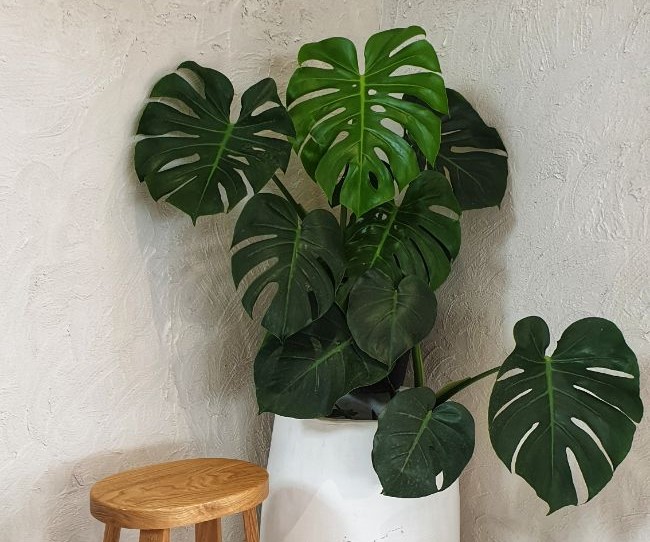
Humidity Requirements
Unlike many tropical plants, Monstera deliciosa is more forgiving if the air is a bit drier. However, it is native to rainforests where humidity is a constant and creating humidity around your plant produces the best and healthiest growth.
Don’t feel you require a meteorology degree to create a humid environment for your Monstera deliciosa, because actually, the methods are quite simple.
- Group your houseplants together to create localized increased humidity that all your houseplants can benefit from.
- Place the container on a large, pebble-lined tray. As you water, it runs from the pot’s bottom drain holes onto the pebbles and into the tray. Humidity is created around the Monstera deliciosa as the moisture in the tray evaporates.
- If there’s appropriate space and lighting in your bathroom, you can successfully grow your Monstera deliciosa there. The constant use of water through use of the sink, shower and bathtub creates an adequate amount of humidity for the plant.
If you’d like more ideas to increase humidity, read this article which covers 10 ways to easily increase humidity for your houseplants.
Monstera Deliciosa Fertilizer Requirements
During the growing season of spring through summer, feed your Monstera deliciosa monthly using an all-purpose, water-soluble fertilizer. This is the fertilizer I use for my monstera, and many of my other house plants too. You can easily apply the fertilizer when you water. Monthly feedings keeps the plant growing healthily and those eye-catching leaves glossy and green.
However, stop all feedings during fall and winter, as the Monstera deliciosa has entered a dormant stage and growth slows or stops. Once the warm weather of spring arrives and growth resumes, you can restart your monthly feedings.
After several months of fertilizing, you will want to flush the soil to remove any salt buildup, which can leave the leaf tips yellowed and burned.
- If your Monstera deliciosa is small enough to fit easily in the bathtub or sink, you can flush the soil by allowing the water to run slowly through it and then allow the water to drain from the pot and place the Monstera deliciosa back where it was growing.
- If the Monstera deliciosa is too large to flush indoors, you can take the plant outside to a hose and allow the water to run slowly through the soil for around five minutes. Once the excess water drains from the container, you can bring it back indoors.
An alternate option for fertilizing your Monstera deliciosa is using all-purpose, slow-release fertilizer granules sprinkled over the soil. Depending on the specific brand, most slow-release blends work for about three months before needing replacing, slowing breaking down in the soil with each application of water.
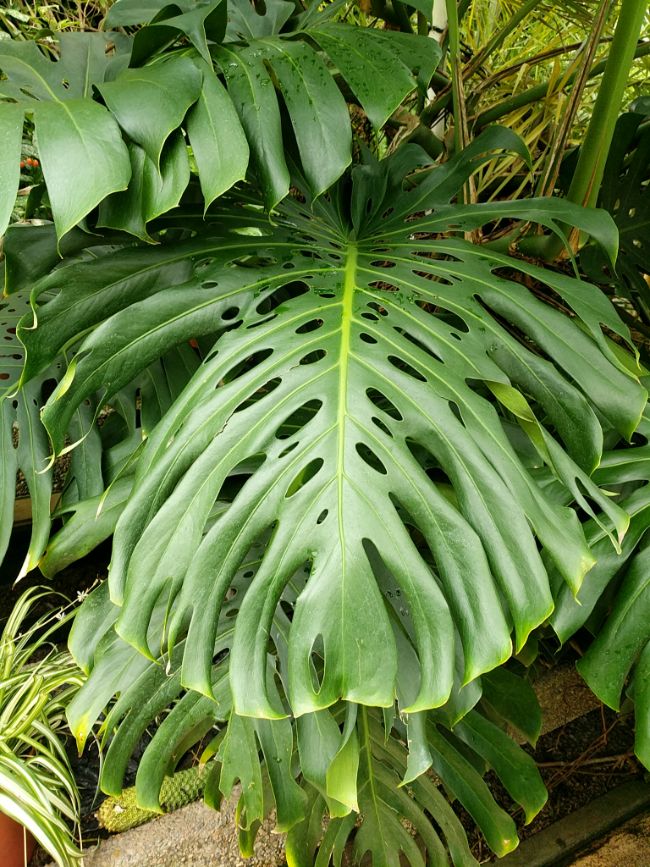
Pruning Monstera Deliciosa
Monstera deliciosa is considered a low-maintenance plant when it comes to pruning needs. The only pruning required is to maintain its size or to remove dead or damaged foliage, snipping the entire leaf and attached stem back to the plant’s main or central stem.
Some people are sensitive to the plant’s sap, so you may want to don a pair of gloves before you start cutting. In addition, and so you don’t accidentally transfer an unwanted disease or pest to your Monstera deliciosa, make sure you use clean cutting tools when pruning. This is as easy as wiping the blades off with isopropyl alcohol.
Planting And Potting Tips
When grown in ideal conditions and given proper care, Monstera deliciosa can increase in size relatively quickly. If you want your plant to grow to its full potential, you should increase the size of the pot each time you repot. On the other hand, if you don’t want your Monstera to turn into a real life monster, you can maintain a smaller size by limiting the size of the container.
If you purchased your Monstera deliciosa while it was very small and growing in a 4- to 6-inch pot, plan to repot into a bit larger container at the time of purchase or in the next month or two.
If your Monstera has been growing inside the home for quite some time, you can tell it’s time to repot if the roots are growing out of the pot. It’s best to wait until spring when the plant starts actively growing again to do any repotting.
Some important considerations when selecting a container include:
- Make sure the bottom of the container has drain holes to prevent problems with root rot.
- Monstera deliciosa has a deep root system, so use a deep container and not a shallow one for proper root growth.
- Any type of material work fine for growing your Monstera. However, pots made of porous materials like clay may require more frequent water applications, as the soil dries out quicker.
Basic Monstera Deliciosa Planting Steps
Although technically speaking Monstera deliciosa is categorized as a vine, you can still grow it as a sprawling ground cover or upright plant; you will just have to do some pruning to maintain its shape. The basic difference is you will need to include a structure for climbing if you desire the plant to fulfil its natural tendency to climb upward.
In addition, if you are repotting your Monstera deliciosa in the same container to maintain its smaller size, you will probably have to do some pruning of the underground roots.
As far as the aerial roots and they can grow quite long, you don’t have to worry about them and can let them do their natural thing or redirect them into the potting mix. However, if you feel they make the plant look messy, you can trim some of them off using clean pruning tools.
When you remove the Monstera deliciosa from the original pot make sure to inspect the root system. If it was bulging out of the pot and you want to use the same container, you can trim some back using clean pruning tool blades.
- Remove the Monstera deliciosa from its original container and inspect the root system. Now is the time to do any root pruning, if needed.
- Fill a draining container about half-full with a rich potting mix that drains well. Water the soil to settle it.
- If you are growing the Monstera as a vine, now is the time to place a climbing structure into the pot. A moss covered plank or pole works well and the aerial roots will eventually take hold and grow upward.
- Place your Monstera deliciosa in the center of the pot and backfill the remainder of the pot with the potting mix, making sure you don’t plant the Monstera any deeper than it was originally growing. Firm the soil around the base of the plant using your finger.
- Water the soil again, as well as the moss-covered plank and until it runs from the pot’s bottom drain holes.
- Situate your Monstera deliciosa in a warm location receiving bright filtered or indirect light.

Propagating New Monstera Plants
You can easily propagate additional Monstera deliciosa plants through stem cuttings, so don’t let any go to waste if you have to prune yours back to maintain a particular size. Although you can also propagate plants through planting the seeds, indoor plants rarely bloom and it’s an unreliable process.
Using clean pruning tools snip off a tip section of the Monstera, being sure to include at least one or two aerial roots. Place the cut end into a container filled with rich, well-drained potting mix and water. Your cutting should start developing roots in about four weeks.
In addition, you can also propagate new plants through cutting a stem into 12-inch sections. Press the section into the prepared potting mix about halfway and water the soil. The sections should start rooting in about four weeks.
Cleaning The Leaves
When it comes to a Monstera deliciosa it’s all about those large, shiny green and split leaves, so you’ll want to keep them looking their best. Spritzing the leaves with water works well in removing some of the dust, but you might have to do a bit more to keep the foliage looking its very best.
Some easy leaf cleaning options include:
- Take the entire plant to the sink and rinse off the foliage with a gentle spray of lukewarm water.
- Mix ¼ teaspoon of a mild dish soap into a quart of room temperature water and spray the foliage and then rinse the soap off with lukewarm water.
- Using a damp cloth, wipe the dust off each leaf.
If you’d like to learn more, I’ve written an entire article about the best way to clean the leaves of all your indoor plants.
Disease Problems
Fortunately, Monstera deliciosa is a hardy plant and relatively disease-free, but when overwatered or maintained in consistently soggy soil can have problems with root rot.
One of the signs that a Monstera is being watered too much is the leaves begin sweating. If you notice this happening reduce the amount of water the plant is receiving and only irrigate when the top several inches of soil feels dry to the touch.
Another more serious sign the Monstera deliciosa is residing in conditions that are too wet, are the leaves developing black water soaked areas and stem sections turning black and mushy. If the problem is just rearing its ugly head, you can possibly save the plant by repotting into fresh soil and decreasing the frequency of watering. However, if the damage is too bad, it’s probably best to discard the entire plant and start again with a healthy Monstera.
Pest Problems
Indoor Monstera deliciosa plants are relatively pest-free, but can sometimes be affected by spider mites or mealybugs. Both insects are easily identified and treatment should quickly gain control of the pest problem.
- Spider mites are small, whitish pests that thrive in warm, dry conditions. If you notice a fine webbing covering portions of your Monstera deliciosa, you have a spider mite problem. These tiny insects suck the inner sap from the plant and if left unchecked can eventually weaken the plant to death.
- Mealybugs typically cover where the leaf joins to the stem in a clump of a cottony mass. Like spider mites, mealybugs suck the inner sap from the plant and can weaken it.
When treating both spider mites and mealybugs, quick action is best, as both pests can attack your other houseplants. Spraying the entire plant with neem or an insecticidal soap and repeating the treatment, as outlined on the specific product’s label, should kill the pests.
For the best ways to get rid of all kinds of houseplant bugs naturally, read my article that I’ve written on the topic.
Common Questions
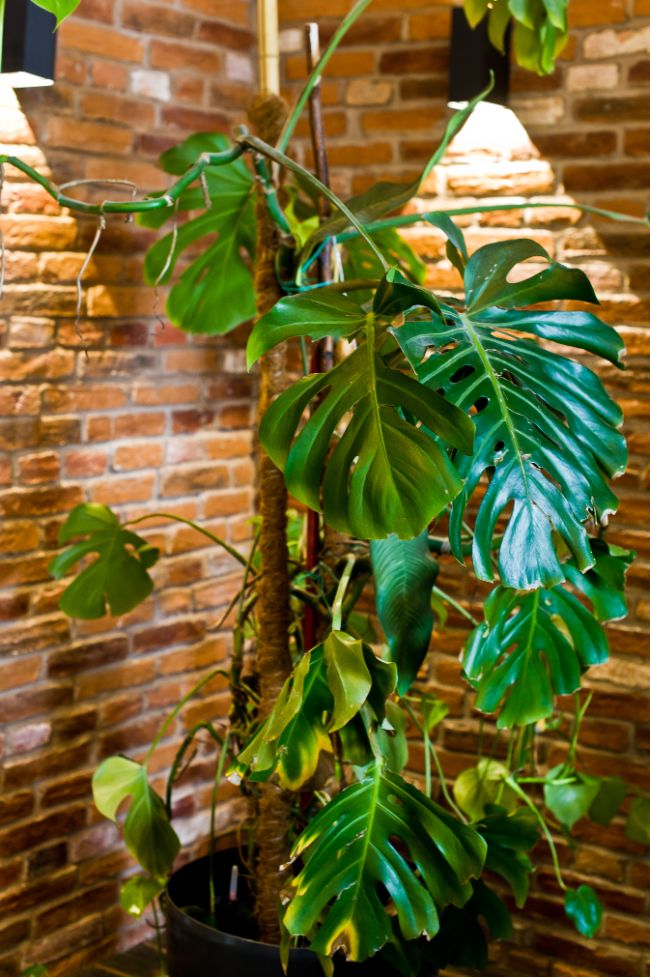
Is Monstera Deliciosa Toxic?
The poisonous component in Monstera deliciosa is oxalic crystals, making the plant toxic to humans, dogs and cats when the leaves are chewed or unripe fruit eaten.
Toxic symptoms include an almost immediate painful loss of voice, mouth irritation, hoarseness and blisters forming inside the mouth. Monstera deliciosa fruit can take up to a year to ripen and become safe to ingest. In addition, it should also be noted that some individuals have allergic reactions to the ripe, edible fruit. An allergic reaction the fruit shows up raised watery welts on the skin.
Should I Repot My Monstera Deliciosa?
Although a Monstera deliciosa grown in preferred conditions has a relatively fast growth, the plant will tolerate growing pot bound in the same container for several years. However, it’s a good rule of thumb to repot into fresh soil and a one size larger container, if desired, once the root system starts outgrowing the present container. This process is best done in spring as the Monstera goes out of winter dormancy.
Why Are My Monstera Deliciosa Leaves Yellow?
The two major reasons your Monstera’s leaves are turning yellow are overwatering and lack of nutrients. If you are watering the plant too much, cut back irrigation until the top several inches of soil become dry to the touch.
For the best green coloring and growth, fertilize the plant monthly with an all-purpose, water-soluble fertilizer, applied at half of the strength recommended on the pack.
Why Is My Monstera Deliciosa Drooping?
Lack of water often causes a Monstera deliciosa to droop, so you can solve the problem by increasing the frequency of applying water, watering deeply when the top several inches of soil become dry. Overwatering can also sometimes cause Monstera deliciosa to droop, so feel the soil first to determine what the problem is.
Why Does My Monstera Deliciosa Have Dry Brown Spots On The Leaves?
If you notice the foliage of your Monstera deliciosa developing dry brown spots, the plant is getting too much sun and the foliage is sunburned, so move it to a location receiving bright filtered or indirect light.
Why Do The Leaves Of My Monstera Deliciosa Have Brown Edges And Tips?
The air is too dry and you need to increase the humidity around the Monstera deliciosa. Use one of these great methods in increasing humidity, if the foliage loses its gloss and the edges become outlined in brown.
Why Are The Leaves On My Monstera Deliciosa Turning Pale?
If you notice the foliage on your Monstera deliciosa becoming pale green and taking on an almost translucent look, the plant isn’t getting enough light and needs to be moved to a location receiving bright indirect or filtered light.
Why Does My Monstera Have No Or Few Perforations?
Monstera plants will develop perforations in their leaves when their care needs are being met and they are thriving. Lack of perforations indicates that some aspect of their care is inadequate. Go through each aspect of care and ensure you are providing your Monstera with everything it needs.
Are Their Different Types Of Monstera Deliciosa?
There are thought to be more than 90 different species within the Monstera genus, a few of which are commonly grown as houseplants, including Monstera adansonii. Discussing all of these is a whole different article.
There are also a smaller number of cultivated varieties of Monstera deliciosa, and some of these are well worth discussing.
Monstera deliciosa ‘borsigiana’ looks visually very similar to Monstera deliciosa, but is a smaller plant, with leaves that are rarely more than 60cm in diameter. A good option for those looking for a smaller option, but it can often be very difficult to know what you are buying with certainty.
Monstera deliciosa ‘Thai Constellation’ is a beautiful and very popular variegated cultivar, which has chimeric variegation. Widespread white spotting of the leaves and white sections look beautiful. Easier to propagate and find than other variegated cultivars.
Monstera deliciosa ‘Albo-Variegata’ is hugely popular and can be very expensive and difficult to find. The leaves tend to have more distinct variegation that is very visually striking. has Check out this article for some beautiful images of the most popular varieties and cultivars.
Last Word
Many thanks for reading this in depth look at how to care for Monstera deliciosa. Hopefully I’ve covered most of the common issues and questions, but please get in touch if you are still having any difficulty with your plant.

